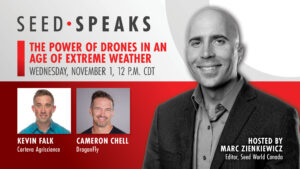In recent years, the increasing frequency and severity of wildfires and extreme weather events have posed significant challenges for both wildfire mitigation efforts and the agricultural industry. However, innovative technologies such as drones are emerging as powerful tools in addressing these challenges.
On a recent episode of Seed Speaks, Draganfly CEO Cameron Chell and Corteva Agriscience Field Modernization Scientist Kevin Falk shared their insights on how drones are revolutionizing wildfire detection and mitigation and revolutionizing agriculture in the face of climate change.
Drones in Wildfire Mitigation
Draganfly, a Saskatoon, Sask.-based company, was recently awarded a multi-year wildfire mitigation services contract to deploy specialized technology and drone pilot crews to detect and map wildfires and hotspots across British Columbia. There’s also a huge amount of interest from United States officials in Draganfly’s technology.
According to Chell, drones play a vital role in four key areas related to wildfires:
- Preventative Measures: “Drones can be employed to collect valuable data for predicting and preventing wildfires,” he says. By monitoring and assessing environmental conditions, drones can help identify potential fire risks in advance.
- Active Wildfire Management: “During a wildfire, drone crews can work alongside firefighting teams to assess fire lines, breaches, and hidden hotspots that may be challenging to detect from the ground or via traditional aerial methods. Thermal imaging technology on drones is particularly useful for identifying hotspots, especially at night.”
- Active Equipment Delivery: Drones are now being used to deliver essential firefighting equipment, such as shovels, hoses, gas cans, water, and medical supplies, quickly and efficiently, reducing response times and increasing overall effectiveness, according to Chell.
- Suppression Techniques: “Soon, drones will be working in swarms to carry out suppression efforts by dropping retardants and pellets, enhancing the firefighting arsenal.”
Falk points out that smoke from wildfires can significantly affect crop growth and yield, reducing the sunlight available to plants.
“Research suggests that the impact on crops from recent smoky conditions may be limited, but the rise in smoky days in certain regions is prompting more research into understanding the effects of wildfire smoke on crop ecosystems,” Falk says.
Spray drones are also being explored to control vegetation near powerlines in rough terrain, reducing the risk of fires caused by trees interacting with power lines.
Drones in Agriculture
Falk emphasizes the role of drones in agriculture, particularly in plant phenotyping. Drones can collect data on crop health, biomass, disease outbreaks, nutrient deficiencies, water stress, and more. This data provides a wealth of information for farmers and researchers, leading to improved crop management, reduced variation in research trials, and enhanced insights into plant breeding and seed development.
Moreover, drones are being used to identify suitable locations for research trials by assessing soil types, elevation, drainage, and crop history, allowing for more efficient trial designs.
“Future advancements might involve how we conduct research including adjusting trial plot sizes to accommodate drone sensors better and increase the number of replicates, providing a deeper understanding of crop performance,” Falk adds.
As the use of drones becomes more widespread in wildfire mitigation and agriculture, both Chell and Falk see promising developments on the horizon.
“I’m excited about the potential of collecting more data and utilizing various sensors to enhance our understanding of environmental conditions and to develop strategies to prevent wildfires,” Chell says.
Falk adds that he’s particularly intrigued by the increasing use of spray drones in agriculture and the growing accessibility of drone technology to a wide range of users.
“Drones are becoming easier to use and more affordable, making them valuable tools for farmers and researchers alike,” Falk adds.










